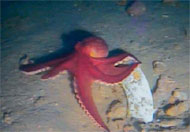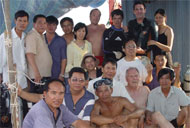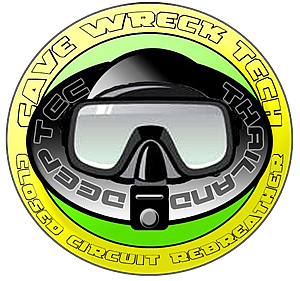Text & Photos by: Bruce Konefe
Cave Diving Vietnam
I have come to believe that I have the best job in the world. It may not be one of the highest paying jobs financially but the job does definitely have an awful lot of benefits. My career as a diving Instructor has allowed me to travel all over the globe. The most recent of my adventures took me to the beautiful country of Vietnam. The Vietnam government was notified about some ancient pottery that was caught in fishing nets just off the coast. The government had put an exploration team together to locate, film and bring up some samples of the pottery. A lot of wrecks are located by fishermen that happen to snag their nets onto a sunken wreck. Normally a fishing boat captain will log the GPS heading of the wreck into a computer so that they will not loose nets on the wreck again. The second reason is so that they can drag the nets near the wreck to catch the swarms of fish that make the wreck their home. Fishing trawler captains can be the wreck enthusiast’s best friend.
The local Vietnamese captain who stumbled across the wreck had contacted Augustine Vinh a Vietnamese collector of ancient pottery. In return Augustine had contacted Nikolaus Count Sandizell who is the CEO of the company Arqueonautas, which has a fine reputation locating and determining exactly how old a wreck is and where the it come from. Arqueonautas has teams of archaeologists and divers all around the world working on ancient wreck sites. Niki Sandizell had contacted Mike Doyle of Indochine Divers to take care of the deep diving team and the equipment. Doyle, a US citizen who has been living and working in Vietnam for many years, is known for his deep diving, wreck and cave diving abilities.
Somebody has to do it…
The first day of my trip started out at Indochine Divers, located in Saigon and owned by Doyle. After settling in we had to prepare enough equipment for all of the divers. Once this was completed we pumped enough double-tanks and deco-tanks to last the trip. I guess pumping tanks might not be the most exciting part of the job, but somebody had to do it. After double checking all of the equipment, the rest of the team showed up in time to help load everything into the truck. which took the tanks and equipment to the diving vessel in Vung Tao. We arrived there in the evening and got everything loaded onto the boat. I was quite surprised to see the vessel I would be spending the next five days on. It was very well set up for a comfortable trip, including showers, bunks for all of us to sleep in and served three hot meals a day.
It took around 19-20 hours to cover the 240km (150 miles) or so to the location. To help pass the time. I helped a gentlemen by the name of Bob Williams set up his equipment. Bob is the owner of the Aqua Scan International. His job was to actually locate the wreck and take pictures of the pottery on the bottom. For the first couple days we used a side-scan sonar that Bob designed and markets. The side-scan sonar is towed behind the boat and gives a detailed printout of the ocean floor.
Once we had found a few interesting marks from the side-scan sonar in one general area, Bob decided to send down a camera to take some pictures to see exactly what was there. The camera was mounted on a tripod and we were able to control the camera from the boat. Bob had designed the camera so that it would be able to rotate through 360 degrees. Whatever the camera was pointed at we could see on a TV monitor. I counted as many as 10 people sitting around the monitor screen at once hoping to see the first signs of the wreck. I would have to admit that I did have my doubts of ever finding the wreck. Staring at a sandy bottom has to be the hardest (and also the most boring) part of the job. I was sitting there watching people starting to doze off when all of a sudden someone yelled out. Everybody jumped to their feet and people ran out from the cabins.
Right location…

Creature of the Deep
Getting the boat positioned next morning was difficult: such a large vessel cannot stop and start quickly, and we had to contend with the tide change as well.
After all of this work the fun was to begin. Now it was time to kit up and get wet. The depth of the dive was to be 80m (262ft) and we planned to do two dives. The first dive was more of an exploratory dive and the second dive was to collect some samples and see exactly how large the wreck actually was. The first dive had a short bottom time of only 16 minutes. This was just enough time to get to the bottom and do a quick search. For the dives I chose to use a 50% helium mixture with a 15% O2 for the bottom mix. For the decompression we used a 32% O2 and a 15% helium with a second deco gas of 50% O2 and 50% N2. I had selected these gases due to the low CNS and also in case of a loss gas situation. I had used the new ANDI-Gap dive planner software to plan our dive schedule. On this dive each diver was to carry four tanks, two back mounted tanks of bottom mix and two tanks of deco mix. I elected to carry one extra tank of bottom mix to leave at the bottom of the descent/ascent line while we were exploring for extra safety. This dive planner would have us out of the water in around 80-minutes. Being this far offshore I definitely wanted to make sure everything was well planned and safe. Safety divers, medical supplies and an extra 7 cu metre tank of oxygen were on the boat just in case anything went wrong.
The divers picked for this dive were myself, Niki, and an archaeologist employed by Arqueonautas named Alejandro Mirabal. I had prepared the equipment and everyone got kitted up, did routine buddy checks and made sure that we had all of the equipment. All of the double-tanks were put on and once we were in the water we clipped on the additional tanks. Again we rechecked the equipment before beginning the actual descent. On our descent we made quick checks at 2, 5, and 10 metres checking for leaks, buoyancy, and ensuring there were no equalisation problems. Once to the bottom we reeled out to search the area. We were unable to locate anything on the first dive do to problems with getting the boat positioned properly. This is not the first time I came up empty-handed and it probably won’t be my last. Every dive cannot be a success.
Second attempt

The Team
When I returned to the ascent line Niki and Alejandro where already there, getting ready for the ascent to the first of many deco-stops. On the deco-line I signalled to Alejandro and he signalled to me that he had found the three pieces of crockery by the camera’s tripod. I didn’t give them any clue that I had found anything. On this dive the current was quite strong on the deco. I put the valve of the deco-tank around the rope so that I would not have to hold on to the line for the next hour. I knew I should have brought my Jon line on this dive!
Once our deco-stops were over we swam over to the stern of the boat one at a time. We got out of our gear and passed the equipment up to the boat crew. There where quite a few people filming and taking lot of pictures of us once we got on the boat. The entire camera crew were aimed at Alejandro right up to the point when I pulled out two unbroken pieces of blue and white pottery. I thought Niki was going to wring my neck when I pulled them out of my pocket since he did not have a clue that I had them. We had spent an hour on the deco-line and I had never let them know that I had found anything.
On the way back to shore we spent hours packing up all of our equipment. The trip had lasted one day longer then expected but was definitely worth it. After arriving back at shore there were meetings and dinners planned with the government of Vietnam. We showed the government and the local museum the pottery that we had found and short film clips of the wreck itself. At this time full reports are being prepared to submit to the Vietnamese government. The pottery is being examined by the museum of Vung Tao and other archaeologists to determine the exact age of the pieces that we found and where they originated.
There are people all over the world that only dream about doing things like this and I am one of the lucky ones that has been on many expeditions just like this one. Being able to do dives like this does inherit a lot of risk. Before attempting any diving activity, make sure you receive the proper training. If you ever do stumble across one of these wrecks, you should contact local authorities. A wreck is only a wreck until you can put some history to it. This is the job of the archaeologists who can put all of the clues together and to put it on display for all of us to see.

